Morse Code CW Keys & Keyers: An Essential Guide
Discover the basics of Morse code or CW keys & keyers with this comprehensive guide which is perfect for amateur radio CW & telegraphy enthusiasts.
Morse Code includes:
What is Morse code
How to learn Morse code
Morse code table / chart
Morse code keys & keyers
How to choose the best Morse key
How to use & set-up straight Morse key
How to use & set-up mechanical bug key
CW QSO
There are several different type of Morse key or CW key. Straight keys, telegraph keys, hand keys, mechanical bug keys, Vibroplex bugs, el-bugs, paddles, single paddles, iambic paddles are all names for various forms of Morse key.
Whilst there are many different types of Morse key or CW key, the various types of key can be used in different ways, and different people have different requirements and preferences.

The different types of Morse key can be used for different purposes, so sometimes it is necessary to choose the right CW key for the right occasion. Sometimes, people may have two Morse keys wired in parallel to meet the different demands of different occasions.
Today Morse code keys are generally used for amateur radio communications as well as by a few telegraphy enthusiasts. However int he past Morse code was one of the mainstays for all forms of radio communications, and especially for maritime work.
Over the years, a considerable amount of development has been invested into Morse keys and this can be seen in the variety of different types of Morse key: some ideal for the early telegraphy systems; some for modern two way radio communications; some that are equally applicable to both.
Morse key history
The Morse key has undergone a considerable amount of development and it has been the subject of a large number of patents.
Note on Morse Key History:
The Morse key developed from the first very simple 'Correspondent' key through later developments including the 'Lever Correspondent' to steel lever keys and many more versions of straight keys. Sideswipers started to reduce the number of movements required, but the mechanical bug was then introduced and this increased the sending speeds as well as reducing the strain on operators. With electronics becoming more widespread electronic keyers were introduced producing both dots and dashes and many new transmitters / transceivers included the electronics thereby requiring only a paddle externally.
Read more about Morse key history.
Types of Morse key
There are several types of Morse key and keyer that can be used today for radio communications activities and these cover a wide range of approaches to sending Morse and the budgets for them.
Most Morse keys and keyers mainly fall into these main categories:
Straight Morse key: The straight Morse key is the traditional form of Morse key that has a lever and uses an up and down motion to make and break the contact and hence make the dots and dashes. Sometimes this sort of key may also be referred to as a pump handle key.
Sideswipers: As Morse telegraphers used to send Morse for long periods they started to experience a syndrome called Telegraphers Cramp, which would be known to day as Repetitive Strain Injury. The first step in overcoming this was the sideswiper Morse key. These keys are not used very much these days and they are not manufactured.
Mechanical semi-automatic keyer: The semi-automatic Morse key or "bug" key was the next development in the line of keys to ease sending and increase speeds. The key had a paddles and when moved to the left made contact for the dashes, and when moved to the right, it set a vibrating arm in motion to create the dots.
Electronic keyers & paddles: The electronic keyer is an electronic development of the mechanical key. The basic version has a paddle which creates a series of dashes when moved to the left, and dots when moved to the right.
The electronics may be included in the keyer, or more commonly these days the electronics is incorporated within the transceiver so that only the paddle is required externally. This significantly saves on the cost and also on space as the paddle does nto require the case for the electronics, or the power / battery.
Computer driven senders: Although full electronic keyers are available, most modern ham radio transceivers have the keyer electronics contained within the transceiver and only the paddle is required. This simplifies their installation and enables fast two way radio communications using Morse code.
Further details of all these types of Morse key are given below.
Straight Morse key
The straight Morse key is still in widespread use by many Morse enthusiasts including ham radio operators. Sometimes these keys may also be referred to as "pump" handle keys because of their construction and shape.
This is the form of Morse key that everyone associates with radio communications applications - any film showing wartime radio communications will have this type of key shown in it.
The straight key is a development of the first Morse keys that were used in the early telegraph systems. Despite the age of the technology, it is still very effective.
Video: Morse Code Keys: straight or pump handle: what they are, how they work & what to look for when buying one
The basic key consists of a lever with a bearing in the centre. It has a handle on one end is moved up and down to make and break a contact and thereby provide the keyed signal.
There are literally thousands of differnet types of Morse key, so there is no such thing as a standard key, but in general most keys fall into one of two main categories:
Fixed bearing Morse key: This type of Morse code straight key has the roots of its design in Europe. It tends to be quite heavy and has a thickish lever and generally made from brass. The pivot, often with a bearing is about half to two thirds along the lever. The knob, which is generally rounded is at the front end and the contacts for making and breaking the circuit are on the underside of the lever between the knob and the pivot. The other side of the contact is fixed to the base.
At the other end of the lever, there is a stop adjustment and this adjusts the movement of the lever. There is also a spring which holds the key in the open position when contact is not required.
Modern versions of this type of Morse code key tend to have ballraces in the pivot of the lever. Even though the movement of the lever can be small, the use of these ballraces or bearings can have a significant effect on the 'feel' of the key and its operation.
Often the key is mounted on a wooden base with two metal sections separate so that the they are insulated from one another. Also the knob for the key may be 50 to 60mm above the table surface and this may be a significant factor in choosing whether to use this type of key, or the other type.

British Post Office Morse key The British Post Office Morse key is an ideal example of this, and from the photo, the general construction can be seen, along with the bearing to provide the smooth rocking action for the lever.
Steel lever key: The steel lever key was developed for the American telegraph operators. It is typified by the base that is generally oval in shape and the comparatively thin steel lever (compared to the British Post Office key, for example). This gave a light weight Morse code key and this was important because the American telegraphists were normally itinerant and took their keys and sounders with them. Accordingly they needed a lightweight key.
The 'knob' was much flatter and generally it is only about 20 mm above the work surface.
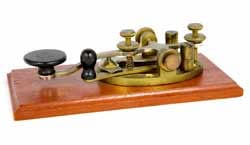
A steel lever Morse key Another aspect of these keys is that they have a slider to short the contacts. This was effectively a send receive switch for the telegraphers as when they wanted to receive messages, their key had to be shorted so that the circuit was enabled for the other end of the line to send messages. For current day amateur radio and other radio communications operations, these contacts can be used as a 'key down' position for tuning, etc if needed, although most modern amateur radio transceivers have a special tune position, although for low power, QRP operation with home build radio communications equipment, this can be useful.
For these Morse keys, the bearings were at either side of the steel lever and these are normally adjusted to ensure the correct positioning, and pressure on the lever for easy operation.
When choosing a key for personal use, it is necessary to have one that feels comfortable. It is very much a matter of personal preference, and there is a wide selection from which to choose.
The adjustment of the Morse key is also important. The gap between the contacts should be adjusted to suit. Often wider gaps are used for slower speeds where it is possible to have time for the additional movement, and much narrower gaps are used for faster speeds. The key should also be mounted so that the wrist is supported, and this is important when long spells of operating are envisaged.
Sideswiper Morse key
Although the sideswiper Morse key was a major stepping stone in the development of Morse key technology, these keys are rarely seen or used today. These keys tend to only be seen in the collectors market places and even then only rarely.
In terms of operation, they were overtaken by the mechanical "bug" keys that sent the dots automatically.
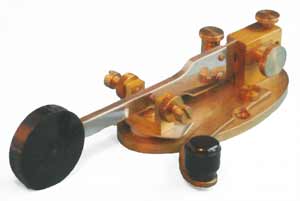
The basic concept of the sideswiper Morse key is that it has two contacts, one either side of the central position. The lever can be moved from side to side to produce the dots and dashes. The operator can makes dots and dashes on either side.
The key takes quite a bit of getting used to, and as it does not provide the same improvements in speed and ease of use as other later developments, and as a result very few sideswiper keys are seen these days - often only in collectors markets, etc.
Semi-automatic mechanical keyer or "bug" key
The Vibroplex is the most famous form of bug key. However the Vibroplex, along with other forms of mechanical semi-automatic Morse key are still in widespread use.
The bug key consists of a relatively complex structure, having a paddle connected to an arm. When moved one way it makes contact with a contact so that the dashes can be made, and when moved the other way, a spring loaded armature vibrates to make the dashes.
After using a straight Morse key, a bug key takes a little practice to get used to because it is necessary to not only get used to the sideways movement, but also keeping the paddle over to the left to make dots, and not make them individually. Also getting used to manually making dashes, and not the dots. However with a little practice it becomes second nature.
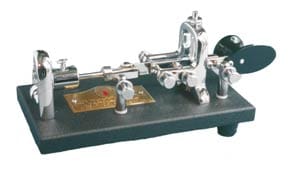
A variety of mechanical bug keys are available these days. Although they have been overtaken in terms of technology by electronic keyers, many people still like the mechanical bugs.
It is possible to obtain a variety of different mechanical bug keys. The main manufacturer these days is Vibroplex. This company was the company that launched the mechanical bug key into widespread use with telegraphers back in the nineteenth century.
The Vibroplex company has changed hands a number of times in recent years - as the key is no longer used in large quantities and really only by radio hams and other telegraphy enthusiasts, the market is much more limited. Nevertheless the company is still in existence and produces some very impressive keys.
Over the years, mechanical bug keys were manufactured by a number of other companies, although these days, the main source is Vibroplex.
Fully automatic electronic Morse keyers or "El-bugs"
With the advancement of electronics, fully automatic keyers that generated dots and dashes were eventually produced. Some of the earliest designs date from the 1940s, one even appeared in the April 1940 edition of QST, the magazine of the American Radio Relay League.
Since the the first fully automatic keyers were introduced, a considerable amount of development have been made in their technology.
The technology for these keyers has been further enhanced and most are now able to store strings of letters or pre-set messages. In this way for ham radio contests, or other forms of operation, frequently used messages can be stored and sent quickly and accurately.
There are several variations of electronic Morse keyers that are available.
The popularity of fully automatic electronic keys has developed toth e extent that most modern amateur radio tranceivers only require an external paddle, either single paddle or iambic dual paddle. There is typically one socket for a traditional key, and another for a paddle.
Electronic Morse keyer: This term really refers to a keyer that includes the mechanical paddle as well as the electronics to create the dots and dashes. Some keyers incorporate a reed relay so that high voltages can be switched - this may be required if valve vacuum tube transmitters are being used. Other keyers may use a transistor interface.
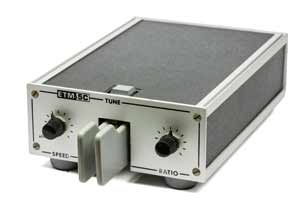
A typical electronic keyer Typically these El-bugs are a direct replacement for a straight Morse key, and may often be wired in parallel with one so that both approaches for sending Morse may be used.
El-bugs are less widely used these days in the form of the complete external keyer in a box as other solutions have taken over, occupying less space, and providing better performance at a lower cost.
In the late 1980s and early 1990s a number of Morse keyer integrated circuits were manufactured and these set in place the foundation for this approach. It became very cheap to incorporate the keyer circuitry into the transceivers, leaving the external paddle to be provided externally.
Iambic keyer: Iambic Morse keys or "squeeze" keyers provide dots when one paddle is moved to the right, dashes when one of the paddles is moved to the right, and a series of dot-dash-dot-dash . . . when the two paddles are squeezed together, the first Morse element, i.e. a dot or dash dependent upon which paddle is moved first.
Iambic mode keyers are very useful for sending characters like 'C' and 'period' and to a lesser extent, 'K' and 'R' where alternate dots and dashes alternate to make up the code for the character.
Today, the iambic capability is taken as a given on all transceivers fitted with Morse capability and an external iambic paddle. In the early days of iambic keyers an integrated circuit called the Curtis chip was widely used - later the WB4VVF Accu-keyer was introduced.
Within iambic mode there are two modes:
- Iambic Mode A: Iambic mode A keyers complete the element being sent when the paddles are released.
- Iambic mode B: Iambic mode B keyers send an additional element opposite to the one being sent when the paddles are released.
In other words when using an iambic keyer and sending the letter 'C' ( -.-. ) in mode A both paddles are squeezed so that a dash is sent first and then let go of both after after hearing the last dit. With mode B, both paddles must be let go after hearing the second dash.
External paddle: Today, most new amateur radio or ham radio transmitter receivers incorporate the electronic circuitry to provide the keying. All that is needed is an external paddle capable that gives the instruction to the keyer circuitry to make the dots and dashes.
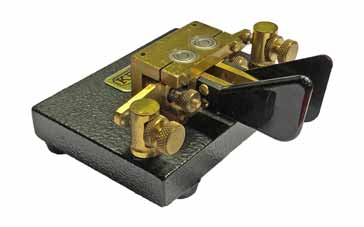
Iambic mode compatible Morse paddle Closing the contact by a left hand movement of the paddles instructs the keyer circuitry to make dashes as long as it is closed, and conversely to the right a series of dots are made. By having the electronic circuitry for the Morse keyer internal to the transceiver, the cost of the Morse paddle can be reduced, or the money spent on providing a better quality paddle.
Paddles can either have a single paddle, sometimes called slap keying in view of the fact that the paddle is slapped from one side to the other, or it can have two. Dual paddle keys are compatible with iambic mode keying as thee have two separate contacts for dots and dashes can be actuated individually or both together. Most of the external Morse paddles available today are dual paddle variants, although single paddle ones can also be seen quite frequently.
Morse keyboards and automatic Morse code generators
Today, there are many processor or computer driven Morse code generators. Morse keyboards can be very useful when wanting to generate long Morse transmissions. While these seem to be items that were a recent invention, it is surprising to learn that the first step in the automation for generating Morse code signals occurred as far back as 1902 when Charles Yetman received his patent for what he called a telegraphic transmitter. Unfortunately this idea was well ahead of its time, and the unit consisted of a typerwriter keyboard that converted the key depressions into Morse characters. The idea did not catch on because the unit was large and expensive. However it showed that it was possible to generate Morse code automatically.
Automatic generation of Morse code had to wait until home computers like the Apple II and the first IMB PCs became available in the early 1980s. With the further development of PCs and sound card technology, full packages became available that could not only send Morse but also decipher it as well. Although these Morse coder readers are not able to copy as well as the human mind under conditions where interference levels are very high, they are nevertheless able to provide good copy under many conditions.
There is a wide variety of keys and keyers which can be bought these days. Selecting the right one may take a little research, but this will ensure that the right key is bought to give many hours of pleasure in operating.
 Written by Ian Poole .
Written by Ian Poole .
Experienced electronics engineer and author.
More Ham Radio Topics:
What is ham radio
Callsigns
Morse code
Voice modes
Digital data modes
QRP operating
Operating awards
Codes & abbreviations
Ham bands overview
Operating via differnet propagation modes
Repeaters
Callsigns
Contact formats
Setting up a shack & buying equipment
Return to Ham radio menu . . .



